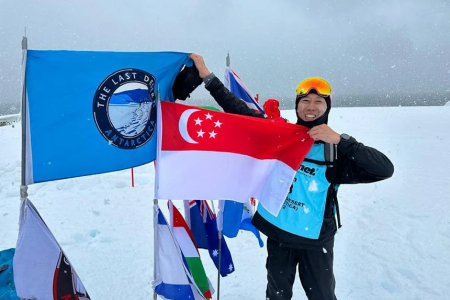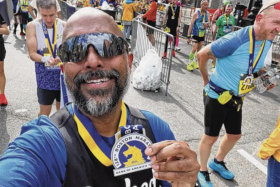PE teacher finishes Antarctica ultramarathon six months after hip replacement surgery
On his 50th birthday on Nov 26, 2022, teacher Koh Suan Lam was trudging on a snow-packed trail in Port Lockroy, Antarctica’s single most visited landing site.
The avid long-distance runner was taking part in the Antarctica leg of the RacingThePlanet 4 Deserts Ultramarathon Series, named by Time Magazine in 2010 as one of top 10 endurance competitions in the world.
It was the second day of the six-day timed race, where participants must complete short, looped courses in several locations in Antarctica and outlying islands while battling frigid temperatures down to minus 20 deg C in the driest and windiest continent on earth.
To qualify for the Antarctica race, Mr Koh completed two of the 4 Deserts Race Series events – the Gobi March in China in 2012, and the Atacama Crossing in Chile in 2020. Both were 250km multi-day treks with point-to-point courses broken up into six stages.
But the Antarctica race was his most gruelling yet.
“On my second day, I was still learning how to run on the snow, and it was really challenging on the ankles and the knees. I fell down quite a few times,” said Mr Koh, adding that he also cut himself with the microspikes he wore over his shoes for better grip on the frozen terrain.
Mr Koh had come a long way from April 2022, when the physical education (PE) teacher was rudely awakened some nights from the excruciating pain in his left hip.
It was the result of his active lifestyle, comprising two PE classes daily and 10km runs three times a week.
He sought help at Alexandra Hospital, and was diagnosed with osteoarthritis, a condition where the cartilage that cushions the ends of bones degenerates due to wear and tear.
By then, Mr Koh had already set his mind on completing the once-in-a-lifetime ultramarathon in December. He would need hip replacement surgery if he wanted to run pain-free.
“It’s not every year that I’m 50… and I thought it would be quite significant to have an event to round up that age,” said Mr Koh.
But hip replacement surgery has risks.
Dr Chua Wei Liang, Mr Koh’s surgeon and Alexandra Hospital’s deputy head of orthopaedic surgery, said that hip replacements involving a standard implant with a ball-in-socket mechanism have up to a 10 per cent chance of dislocation.

But a newer, dual-mobility implant – which has a smaller metal or ceramic head snap-fitted inside a large plastic head – allows for greater range of motion and more stability. The risk of dislocation is half of the traditional implant’s.
“Given that Mr Koh was one of my younger patients, the dual-mobility hip replacement was a better option than the standard. (He also) lived a life of competitive sports, including hardship marathons…
“This technique was the best option to allow him to return to such an elite athletic level,” said Dr Chua, who added that one out of five of his patients is suitable for the dual-mobility hip implant.
Mr Koh underwent the surgery on May 23, and spent six weeks rehabilitating.
Of his first run after the operation in July, Mr Koh said: “It was quite simple because I ran one minute, and stopped for one minute, as advised by my physiotherapist. But (running) gave me such a feeling of happiness.”
He added that it took him about a month before he could go non-stop during a run.

As he recovered, Mr Koh began training for the ultramarathon, clocking 300km a month in September, slowly increasing his mileage to 700km a month prior to the race in November.
An ultramarathon is a running race longer than the traditional marathon distance of 42.195km.
Forty-three participants, including Mr Koh, boarded an expedition ship in Ushuaia, Argentina, on Nov 22.
The group sailed for two days, crossing the Drake Passage, infamous for being one of the most treacherous maritime routes, before the ship docked at the tip of Antarctica.
Over the next six days of the ultramarathon, participants were taken via Zodiac boats (inflatable, pontoon-style boats) to mapped-out routes on land.
“I really can’t explain in words how it feels like to run beside penguins, with seals lying by the side,” said Mr Koh.
“My hip also felt stronger after the ultramarathon, and in fact, I ran faster after I came home from the trip!”
Get The New Paper on your phone with the free TNP app. Download from the Apple App Store or Google Play Store now


